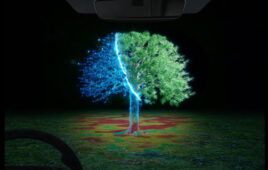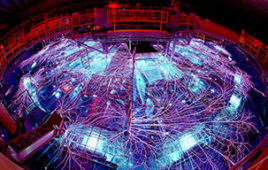 Supervolcanos are not your usual volcanos. By effectively “exploding” as opposed to erupting, they leave a giant hole in the Earth’s crust instead of a volcanic cone—a caldera, which can be up to one hundred kilometers in diameter. On average, supervolcanos are active more rarely than once every 100,000 years; since records began, none has been active. Consequently, researchers can only gain a vague idea of these events based on the ash and rock layers that have survived.
Supervolcanos are not your usual volcanos. By effectively “exploding” as opposed to erupting, they leave a giant hole in the Earth’s crust instead of a volcanic cone—a caldera, which can be up to one hundred kilometers in diameter. On average, supervolcanos are active more rarely than once every 100,000 years; since records began, none has been active. Consequently, researchers can only gain a vague idea of these events based on the ash and rock layers that have survived.
A team of researchers headed by ETH-Zurich professor Carmen Sanchez-Valle has now identified a trigger for supereruptions by determining the density of supervolcanic magma. This enabled them to demonstrate that the overpressure generated by density differences in the magma chamber alone can trigger a supereruption. The magma chamber is located in the Earth’s crust beneath the volcano. The new findings could help us to understand “sleeping” supervolcanos better, including how quickly their magma can penetrate the Earth’s crust and reach the surface.
Magma chamber too large
Well-known supervolcanos are located in the Yellowstone Caldera in the USA, Lake Toba in Indonesia and Lake Taupo in New Zealand. However, the somewhat smaller Phlegraean Fields near Naples are also included in the twenty or so known supervolcanos on Earth to date.
The fact that supereruptions—unlike conventional volcanos—are not triggered solely by overpressure due to magma recharge in the magma chamber has long been clear. A supervolcano’s magma chamber can be several kilometres thick and up to one hundred kilometres wide, which makes it far too big to sustain sufficient overpressure through magma recharge.
“Comparable to a football underwater”
Until now, scientists could only speculate about what triggers a supereruption. One possible mechanism was thought to be the overpressure in the magma chamber generated through density differences between the less dense molten magma and the comparatively more dense rock in the surroundings. “The effect is comparable to the buoyancy of a football filled with air underwater, which is forced upwards by the denser water around it,” says Wim Malfait, first author of the study, until recently at ETH Zurich and now a researcher at Empa.
For the magma to break through the crustal rock above the magma chamber and carve out a path to the surface, it needs an overpressure level that is 100 to 400 times higher than air pressure (10 to 40 megapascals). In order to investigate whether the differences in density can generate such high pressure, the density of the magma melt and the surrounding rock material needs to be known. Until now, however, that of the magma melt could not be gauged directly.
Magma density determined for the first time
The researchers from ETH Zurich have now succeeded in determining the density of supervolcanic magma for the first time with the aid of x-rays from the European Synchrotron Radiation Facility in Grenoble, France, which they used to study artificially produced magma melts under different pressure and temperature conditions. Both the melts and the pressure and temperature conditions corresponded to the natural conditions of a supervolcano, according to the scientists. Moreover, the researchers varied the water content of the melts. Via the different parameters, they formulated mathematical equations, which helped them to reconstruct the conditions in a supervolcano.
“Our results reveal that if the magma chamber is big enough, the overpressure caused by differences in density alone are sufficient to penetrate the crust above and initiate an eruption,” says Sanchez-Valle. Mechanisms that favoured conventional volcanic eruptions, such as the saturation of the magma with water vapour or tectonic tension, could be a contributory factor but are not necessary to trigger a supereruption, the researchers stress in a study published in the journal Nature Geoscience. In an additional, independent study in the same issue of the journal scientists of the Univ. of Geneva and other research institutions conclude from computational modelling that melt buoyancy is indeed key to the eruption of supervolcanos.
Supervolcanos are considered a rare but serious threat. As they are not easy to spot on account of their unusual appearance, new ones are still being discovered today. Supereruptions generally eject at least 450 but sometimes even several thousands of cubic kilometres of rock material and ash to the surface and into the atmosphere. In the event of explosive eruptions, ash and rock fragments with their environmentally harmful chemical components can rise over thirty kilometres up into the atmosphere and have a devastating impact on the climate and life on Earth. The spectacular and serious eruptions of Krakatoa (1883) and Tambora (1815), both conventional volcanos in present-day Indonesia, were comparatively “harmless” and the masses they emitted only amounted to a few per cent of a supereruption.
References:
Supervolcano eruptions driven by melt buoyancy in large silicic magma chambers
Frequency and magnitude of volcanic eruptions controlled by magma injection and buoyancy
Source: ETH Zurich




